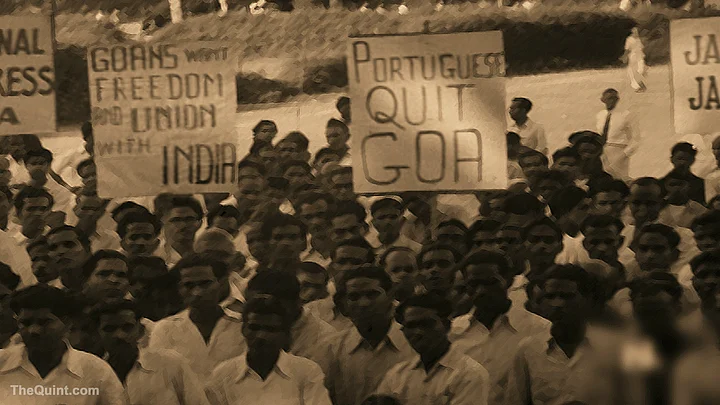(This article was first published on 19 December 2015. It has been reposted from The Quint's archives to mark Goa Liberation Day 2023.)
While India attained independence from the British Raj on 15 August 1947, Goa was still languishing under four and a half century of Portuguese rule.
The Portuguese were among the very first to colonise parts of India, and were the last to leave.
Goa was liberated from Portuguese rule in 1961, on 19 December. Armed guerrillas, satyagrahis, journalists and even legendary film artists fought for Goa’s independence.
Portuguese Oppression
The Portuguese invaded Goa in 1510, and ruled it for over four centuries, subjecting Goans to diabolic torture.
By 1540, the bloodiest period of inquisition began with the persecution of Hindus and Goan Catholics, as well as the suppression of the Konkani language. They destroyed Hindu temples and placed prohibitions on Hindu marriage rituals. Hindus voluntarily converting to Christianity were exempted from land taxes for 15 years. After the Portuguese came under the dictatorship of António de Oliveira Salazar in 1932, things got worse. People were denied basic civil liberties; the right to speech, assembly and press were also taken away. Even simple things like marriage invitation cards were censored.
Winds of Change
June 18, 1946, was the beginning of the end of the Portuguese rule in India.
At a time when the rest of India was inching towards freedom, Ram Manohar Lohia arrived in Goa on the invitation of Goan academician and writer Dr Juliao Menezes. What was originally a visit to a friend evolved into a movement for civil liberties. On learning about the plight of Goans, defying the ban on public meetings, Lohia launched the Civil Disobedience Movement. While Lohia was arrested and the movement quashed, it inspired Goans. People began to meet, organise and strategise. It left a lasting impression on the minds of a number of young Goans like Prabhakar Vitthal Sinari, who was just 13 years old during the movement.
They used to make special whips with Hippopotamus hide – the moment you get whipped, the skin would come off. They started thrashing children with those whips. This was the incident that changed my whole life and I thought I must oust the Portuguese.Prabhakar Vitthal Sinari, Goan Freedom Fighter, and Member, Azad Gomantak Dal
Sinari, along with revolutionaries like Prabhakar Trivikam Viadiya and Vishwanath Lawande were among those brutalised during the movement. These men went on to form a revolutionary outfit called the Azad Gomantak Dal (AGD), which allied with the Rashtriya Swayamsevak Sangh (RSS) to fight the Portuguese.
Nana Kaajrekar, a wrestler from Pune, Sudhir Phadke, a music director and nationalist from Bombay, and others collaborated with the AGD to form a grand coalition called the United Front of Liberation.
Together they carried attacks to first liberate the Portuguese colonies of Naroli and Dadra and Nagar Haveli, before attacking Goa. Famous playback singer Lata Mangeshkar performed at a concert in Pune to help the revolutionaries raise money to buy arms to free Goa, Dadra and Nagar Haveli from Portuguese rule.
Indian Government and International Pressure
After the successful liberation of Dadra and Nagar Haveli, there were great expectations that the Indian Government would use the army to free Goa. But Portugal was part of the North Atlantic Treaty Organisation (NATO), and a young Indian government was not ready to get into a direct conflict with a NATO nation.
Disappointed with Prime Minister Nehru’s tepid response, Goans continued their fight.
The Bloodiest Day in Goa’s History
On 13 June 1955, the working committee of the Jan Sangh met and decided to intervene in Goa. Jagannathrao Joshi, RSS member and Jan Sangh leader from Karnataka, volunteered to lead. He planned to carry out a series of Satyagrahas from June to August 1955. Joshi didn’t even go home to say his goodbyes.
The moment they set foot in Goa, the Portuguese pounced on them. They were abused, beaten and tortured.
Inspired by Jagannathrao Joshi’s spirit, the Goa Mukti Vimochan Samiti carried on with the Satyagraha in Goa. 8000 people from all over India marched into Goa, but the Portuguese were given orders to open fire. It was the bloodiest day in the history of the liberation of Goa – 32 people shot dead and over 225 injured.
Even after the massacre, the Indian government didn’t intervene.
Operation Vijay
Finally, in 1961, at the Afro-Asian Conference in Delhi, India’s hypocritical stance on Goa was questioned. Other nations wanted to know why India was sending soldiers to free other countries from colonialism, while foreign rulers still controlled Goa.
In November 1961, the Portuguese provoked India – they shot a steamer near Anjunim in Karwar, killing one fisherman and also tried to pull out villagers and take them hostage. Portugal also had underlying support from Pakistan and NATO.
Krishna Menon, the then Defence Minister prevailed upon Jawaharlal Nehru that it was time to use force. 30,000 Indian troops with full air and naval support were sent to fight, and in less than 48 hours, Goa was liberated from Portuguese rule.
(At The Quint, we question everything. Play an active role in shaping our journalism by becoming a member today.)
